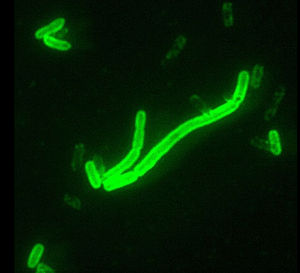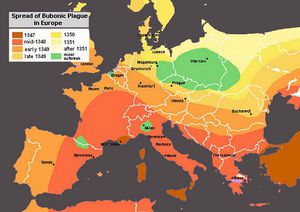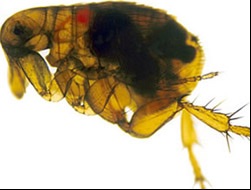Yersinia pestis, the History of the Plague and Adaptation to Animal Host
Classification
• Kingdom: Eubacteria
• Phylum: Proteobacteria
• Class: Gammaproteobacteria
• Order: Enterobacteriales
• Family: Enterobacteriaceae
• Genus: Yersinia
Structure and Significance

By [Blake Calcei]
At right is a sample image insertion. It works for any image uploaded anywhere to MicrobeWiki. The insertion code consists of:
Double brackets: [[
Filename: PHIL_1181_lores.jpg
Thumbnail status: |thumb|
Pixel size: |300px|
Placement on page: |right|
Legend/credit: Electron micrograph of the Ebola Zaire virus. This was the first photo ever taken of the virus, on 10/13/1976. By Dr. F.A. Murphy, now at U.C. Davis, then at the CDC.
Closed double brackets: ]]
Other examples:
Bold
Italic
Subscript: H2O
Superscript: Fe3+
Yersinia pestis, is most notable for the its devastating role in plagues of the past. These bacteria are Gamaproteobacteria that are Gram negative with a coccobacillus shape and are facultative anaerobes. This bacterium causes infection in humans and other non-human animals. These bacteria can be found in animal or insect blood, and this blood is required for the bacteria to survive. The most common hosts of these bacteria include, insects (fleas), rodents and humans. The most notable carrier of this bacteria is the Oriental Rat flea, which contains bacteria in its blood but is unaffected by the bacteria. These fleas then infect rats, which eventually pass the bacteria to humans and other non-human animals. The three main infections caused by this bacterium include: pneumonic, septicemic and bubonic plagues. These diseases are also commonly found in highly populated areas that have poor sanitation habits therefore increasing the rat population and making the location prime for Y. pestis infections. The progression from fleas to rats and the widespread populations of both of these organisms has allowed these bacteria to be exposed to a wide variety of environmental conditions allowing it to adapt to multiple strains that are very resilient. The regulatory systems involved in the virulence of these bacteria have been found to be quite complex posing a large problem for antibiotics.
Discovery
Alexandre Yersin first discovered Yersinia pestis in 1894 at the Pasteur Institute, while a plague occurred in Hong Kong, cause by this Y. pestis bacterium. Yersin was the first to link the plague to the Y. pestis bacterium and therefore the original name of the bacterium, Pasteurella pestis, was changed to the modern name, Yersinia pestis. This outbreak in China, which began in 1855, was said to have killed over 12 million people in both India and China, and was not considered over until 1959. There have been three major outbreaks of plague caused by these bacteria, the plague of Justinian, the Black Death, and the third plague pandemic.
History

The Plague of Justinian
This plague occurred during the 6th century and primarily between 541-542 AD in the Byzantine Empire where it wiped about nearly one third of the population. The location of this plague was Constantinople, to southern Europe and to the east in the Persian Empire. This pandemic is similar to the bubonic plague of the 14th century but has distinct differences, including some victims undergoing hallucinations and delirium, which was not reported during the 14th century bubonic plague. This plague is also one of the first to have been recorded in all of human history.
This plague is believed to have been the first rise of the bubonic plague and DNA research by Wagner et. al, has been conducted on bodies from the era and the bacteria Yersinia pestis was been found. In order to determine if Y. pestis was the cause of this plague the researchers sequenced and analyzed genomes of Y. pestis, which were taken from two specific individuals known to have died in this first plague pandemic. To determine this, teeth were taken from each individual and DNA was extracted. This DNA was then compared to the known genetic sequence of 131 strains that were sequenced from the second and third plague pandemics. Finally the researchers created a maximum likelihood phylogenetic tree. The two individuals used were carbon dated to the period of the first plague pandemic. The branch created for the two Justinian strains have no modern agents, and therefore the Y. pestis that caused the Justinian Plague is either extinct or the strains have not been documented in wild rodent populations. This specific strain of Y. pestis, which is blamed for the Justinian Plague, is distant from the strains that caused the Black Death and the Third pandemic. 3
The Black Death
The Black Death is one of the best-known pandemics that has occurred in human history. This plague is speculated to have begun in Asia and was brought to Europe through trade routes, most notably the famous Silk Road, approximately in 1343. It has been demonstrated through research of DNA from bodies that date to the 14th century, that this plague was brought about by, once again, Yersinia pestis. , The Black Death had a death toll of approximately 75 to 200 million people. With the plague killing such a large portion of the world’s population there were large shifts in religious and economic stages, in European and World history in general.
Yersinia pestis Adaptation to Animal Host
Include some current research, with at least one figure showing data.

Methods for Prevention and Vaccines
Include some current research, with at least one figure showing data.
Conclusion
Include some current research, with at least one figure showing data.
